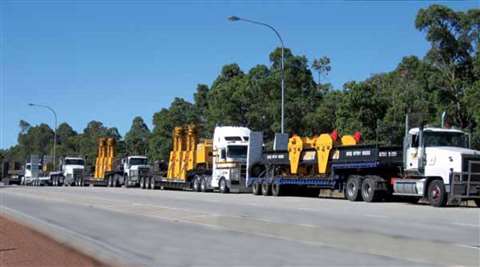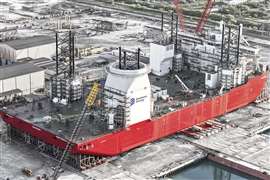Raising The Game
19 March 2008

Users and manufacturers of hydraulic telescopic lifting gantries are seeing a steady increase in the number of new applications being found for their equipment. Hydraulic gantries are being considered for applications that have previously relied on mobile cranes or other types of lifting equipment.
Gary Shepherd, managing director at Machinery Movers, in Melbourne, Australia explains how the upsurge in the country's mining industry has thrown up a range of opportunities there.
The company was contracted to place two 400 tonne autoclaves into a new nickel mine in Ravensthorpe, Western Australia. The autoclaves, part of a leaching system to clean the nickel once it has been extracted, are each 31 m long by five m in diameter and had to be lifted to a height of 9.3 m.
The work was carried out using a J&R Engineering T1102-4-40 Lift-N-Lock hydraulic gantry. The four jack system lifts 500 tonnes to a maximum height of 9.7 m and 330 tonnes to a maximum height of 12.2 m. Machinery Movers bought the equipment five years ago to install presses and injection moulding machines at Australia's four motor companies.
It took Machinery Movers 3½ days, using five semi-trailers, to transport the gantry from Melbourne to the jobsite but just eight hours to unload and set it up. It then took 90 minutes to lift the autoclaves and 20 minutes to place them.
The autoclaves were manufactured in Newcastle on Australia's east coast north of Sydney and shipped by barge 6,000 km to Esperance on the south west coast. Next they were transferred onto 22 line Goldhofer platform trailers for the road trip to Ravensthorpe. The complete transport job was carried out by Lampson International, which subcontracted out the enclave placement work to Machinery Movers.
At AU$ 200,000 (US$ 172,000) Shepherd said his company's contract cost the customer BHP Billiton half as much as using mobile cranes to do the job.
However, the mining company took some convincing that the gantry system could carry out the work. Shepherd says, “BHP is one of the most safety conscious companies in Australia and had to make certain it was up to the task.”
But with massive demand from China for ore, the use of gantries for such applications, along with placing turbine generators and ball mills can only rise, Shepherd adds.
To help meet demand Machinery Movers is awaiting delivery of a smaller, 350 US ton (318 tonne) capacity Lift-N-Lock L702-4-30 gantry, to be used for placing locomotives onto to railway lines in Melbourne.
Taking advantage
“I know there is a lot of work out there that we would like to tender for that it could do successfully. But people know cranes can do the work and it is hard to convince them about gantries. It is difficult to change a person's state of mind and convince them that it can do a job more effectively and a lot cheaper.”
In addition, Shepherd says, gantries are a good alternative to jacking, skating and skidding, which, he says, is time consuming, labour intensive and often puts workers in close proximity to loads when they are in motion.
“Gantries also reduce the installation time, since when skating a load, you can only move the load one axis forward or back. Also, jacking up and down to any height can become unstable, whereas a gantry equipped with J&R header beam PowerLinks can move thorugh three axes and place the heaviest load with the highest precision and the utmost safety.”
John McMahon, sales vice-president at US gantry manufacturer J&R Engineering, agrees that there is a need to educate potential users of hydraulic gantries. “As people learn more about the equipment they can use it for other means. There is still an untapped market out there-people still see cranes as the way to go.”
One of the main advantages gantries have over cranes is their ability to get up and over an interior load without having to remove the roof of the building.
“If you have a 400 tonne load you can set it up around a load in less than a day - a crane takes a lot longer than that,” he adds.
Human interface
McMahon, however, raises one note of caution. With the ever-growing technological leaps in gantry engineering he says it is vital there remains an element of human control, allowing an operator to override the system. “Technology is meant to enhance and not take full control - that is our philosophy. We don't want to totally rely on computers and lose sight of the human interface.”
Heavy lift specialist Hydrospex in the Netherlands installs its Intellilift control system on to all its hydraulic gantries. The system was introduced by the company five years ago and offers automated synchronization and overload detection.
Tjerko Jurgens, Hydrospex managing director, says, “The situation is still that anyone can control a gantry system. There is still not a law against it. Fifteen years ago we could operate a crane without a monitoring system, now you cannot buy a crane without one.
“Now everyone admits that steps we made five years ago will become a new standard. The hydraulic gantry was always a dangerous machine. A lot of customers did not want to use hydraulic gantries. They say that, if you can do it with a crane, it is more expensive but a safer product.”
Other than cranes, Jurgens feels the biggest threat to hydraulic gantries is the strand jack. “Strand jacks, with let us say 100 tonnes capacity, will give you a 400 tonne pick. If you built this on a steel frame it will give you a stable and safe gantry system. It will not be as labour efficient as a hydraulic gantry but it can go into confined spaces easily, better than cranes.
“If you look at the relative investment, this solution is close to a hydraulic gantry, but much lower than a crane. Also, the strand jacks can be used for other applications like load outs and boiler lifts.”
Nevertheless, the gantry sector is booming, resulting in the 12-week delivery period Hydrospex had last year being extended now to six or seven months. This, in turn, has led to change in customer buying habits. “In the past gantries and strand jacks have always been impulsive purchases and, in most cases, the client had a specific job that needed this equipment. The emotional decision of buying equipment is now over, you now have to make a strategic decision.”
There is, however, an answer to lengthy delivery times for users choosing to have their secondhand equipment refurbished, says Jurgens. “It is available for that impulsive purchase and that makes resale value excellent.”
Regarding the future, Jurgens forecasts that the frenzy for new equipment will slow down. “The willingness to invest in new equipment is there, but we see that most of the investments are done based on financing, as long as the banks are willing to give loans the market will stay like it is but, if interest rates are rising and corporate margins stay behind, the market can see a sudden change,” Jurgens adds.
Raising height
Brian Wagner at US gantry manufacturer, Lift Systems, says there is a call for ever taller hydraulic gantries with larger lifting capacities to meet the demands of bigger vessels and transformers.
As a result, the company has introduced risers that can be placed underneath jack legs to create extra lift, rather than customers having to buy new gantries. “This is what we are seeing and we are trying to respond to that. We didn't want to make our customers' equipment obsolete, so we have given them more height to utilise their equipment,” Wagner explains.
In common with the rest of the of the construction industry, Lift Systems is finding demand is outstripping supply around the world. “We had sold tremendous amounts of equipment into the Asian market. Now we are seeing a resurgence there. Having attended Bauma it seems not enough equipment is available-people are now looking to do jobs using another method.
“People are being forced to look at us. There is a new look at a relatively old product.”
In addition to new work coming from other established areas of the construction industry, rental firms are also yet to fully take advantage of hydraulic gantries, Wagner says. “You have got to have the demand and maybe they are not willing to create that demand.”
Part of the problem may have been a slowdown in the US construction industry a few years ago, he explains. “Maybe the thought of equipment sitting around was not attractive to a rental company. But with equipment in short supply you would have thought it would now be an attractive option.”






